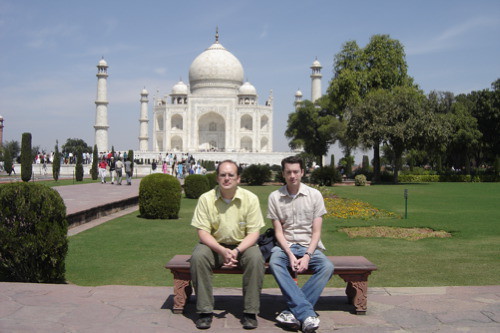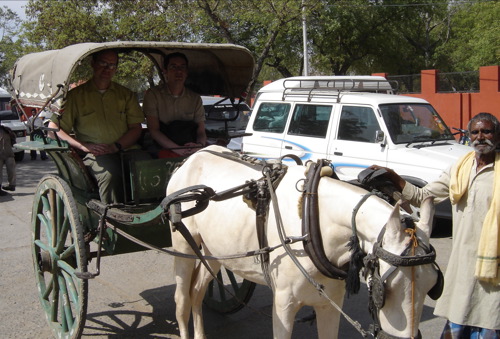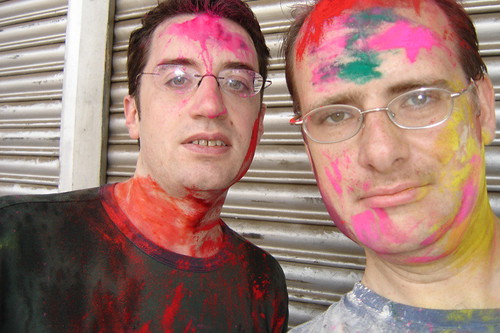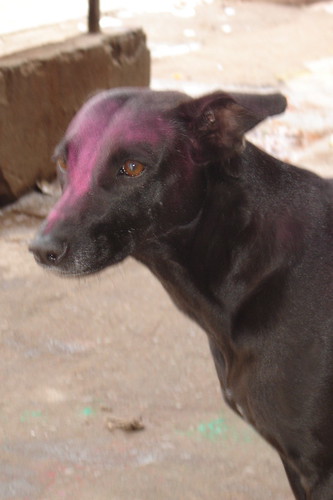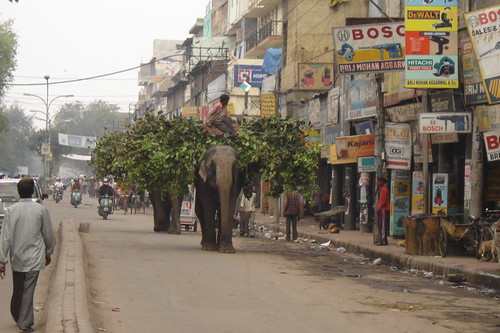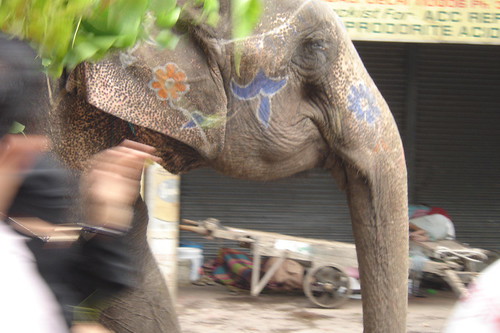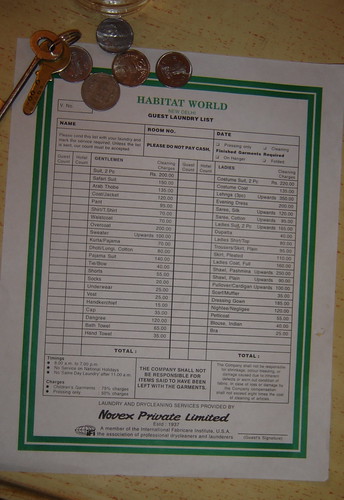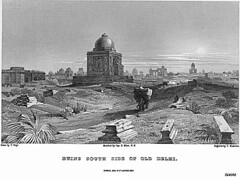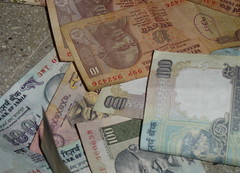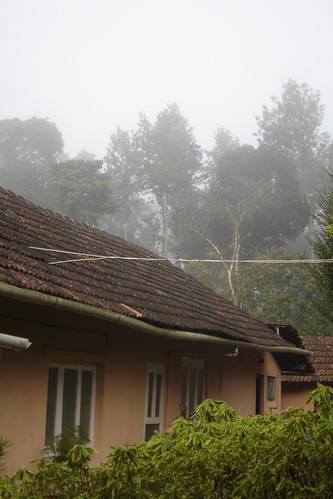
Last week, we had plans to visit the ancient Hindu temple ruins at Hampi, said to be one of the greatest sights of India, and relatively close to us. But we waited too to make our arrangements and the train sold out. So we decided to strike out for another famous district in our local state of Karnataka: Coorg, a mountainous region known for its warlike tribal inhabitants (conjectured to be descended from fifth-century Roman mercenaries fleeing the collapse of the empire) and for its coffee trees, which thrive on Coorg's misty hillsides. Several coffee plantations have accommodations for paying visitors. Our travel agent recommended one, gave us a bus ticket, and sent us on our way.
Getting to the bus was the first adventure; it was slated to depart at 6 a.m., which means we had to find a rickshaw at about 5:15. It's still pitch black at that hour here, and the streets of Bangalore are nearly deserted from about 1 a.m. until sunrise. So as we set out, it was just us, a couple of shifty looking characters eyeing us appraisingly, and several none-too-friendly street dogs. It wasn't looking good, but finally a rickshaw came rattling past and saw a good opportunity to make some easy money. We were happy to pay about two and a half times the normal fare to the bus station (we gave him 80 rupees, or about two dollars). But the adventure did not end there. The Bangalore bus station is vast and poorly marked; most states have their own bus line, and each one operates out of a different section of the sprawling complex. We wandered about in the predawn haze for a few minutes before some kind person directed us to an unpromising-looking corner that turned out to be exactly right. Before long we'd found our bus, a "semi-deluxe" model that featured limited legroom, extremely dirty windows, and no a.c. However, before the end of the weekend I'd look back on this coach as the pinnacle of comfort.
Six hours and only one bathroom break later, we arrived at Virajpet, the end of the line; from here, we took a rickshaw about half an hour up into the hills and into the middle of nowhere. Naturally the driver was unsure exactly how to get us where we were going, but after only a little uncertainty we found the plantation: Alath Cad, just outside a tiny town called Ammarathi. The property consists of the farmhouse, a large modern house built in the traditional Coorgi style, which features tile roofs similar to those you see on Mediterranean villas; the old farmhouse, which is now the main building of the bed and breakfast; a cottage, which is where we stayed; and 75 acres of coffee trees planted in neat rows. The air was clean and cool; the coffee trees were in bloom and giving off a very heady and powerful fragrance reminiscent of orange blossoms or jasmine; all you could hear were the sounds of crickets, frogs, and birds. In short, it exactly the opposite of every part of India I had seen so far, and thus perfect for a weekend away.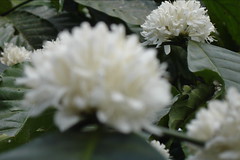
The place was very much a working plantation in the feudal style. The plantation wife, Mrs. Moorg, greeted us very hospitably and then handed us over to two of her retainers, a husband and wife team who look after the guest house. This couple, their children, and some other dependents of the plantation were housed nearby, and we saw many of the workers going about their daily tasks. Mrs. Moorg retreated to her porch, where she sat drinking cool beverages and gossiping with a neighbor. The retainer couple took excellent care of us, first by settling us into the cottage (which was very simple, no tv and only intermittent electricity) and then by preparing an excellent homemade lunch, the first of a series of truly memorable meals we were served here. (The local cuisine features a lot of black pepper and mustard seed, and is unusual among regional Indian cuisines in that pork is a prominent ingredient.) The rest of the afternoon we spent hiking through the coffee trees. They have to be kept shaded, so taller trees are planted along the rows; on these trees, black pepper vines are cultivated, creating a second cash crop without much extra effort.
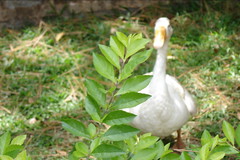 That evening we retired early and slept like logs; the next morning and early afternoon we lazed around, John reading and I doing a little work I'd brought from Bangalore. Butterflies and birds kept us company, as did a small gaggle of domestic geese who noisily made their way around the buildings as they grubbed for roots and bugs. Too soon it was time to go back to the bus station; we loaded up our bags with the ground plantation coffee and whole peppercorns they sell, and waited for the rickshaw to come pick us up. Mrs. Moorg graciously invited us up to her porch to sit while we waited; we chatted with her and her husband for a few minutes about the coffee business. They grow robusta beans, which are exported to Europe for blending; the coffee mostly available for sale in India is imported from Vietnam.
That evening we retired early and slept like logs; the next morning and early afternoon we lazed around, John reading and I doing a little work I'd brought from Bangalore. Butterflies and birds kept us company, as did a small gaggle of domestic geese who noisily made their way around the buildings as they grubbed for roots and bugs. Too soon it was time to go back to the bus station; we loaded up our bags with the ground plantation coffee and whole peppercorns they sell, and waited for the rickshaw to come pick us up. Mrs. Moorg graciously invited us up to her porch to sit while we waited; we chatted with her and her husband for a few minutes about the coffee business. They grow robusta beans, which are exported to Europe for blending; the coffee mostly available for sale in India is imported from Vietnam.
The bus ride back -- how to describe it? Well, let's just say that no "semi-deluxe" coach was available for the return trip, so we had to make do with a bare-bones, economy-class Indian bus, the kind most travel guides strenuously warn you against. We were packed in rather tightly, to put it mildly, and the shock absorption capability of the bus was more or less nonexistent. At first it was kind of fun, like being on an amusement-park ride, but by hour two it was getting awfully old, and by hour three, when we had to change buses in Mysore, I was keeping an eye out for any old semi-deluxe coach headed to Bangalore, ready to pay any price. No luck, though -- it was another cattle car that was headed the way we wanted to go, so we slurped down a quick coffee and wedged ourselves in.
The important thing is that we made it home in one piece, and that we had a great weekend in a beautiful setting. What's more, we can feel adventurous for braving the Indian bus system in two of its less tourist-oriented forms. However, I'll freely admit I'm looking forward to our next journey (which is a work trip to Delhi) not least because the mode of transport will be business-class air travel.
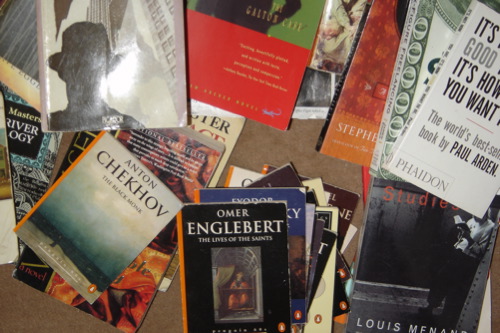
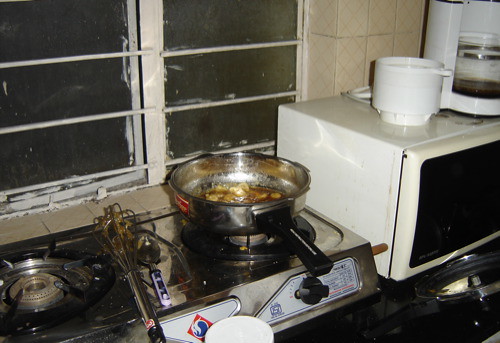
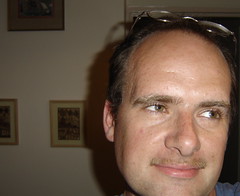 Since we've been in Delhi, I've been growing a small mustache. It just seems like the right thing to do -- Indians guys, especially those in the south, LOVE their facial hair. I've never had one before, so it's looking weird (and lopsided) right now. It's also coming in a lot lighter than my hair, so I doubt that many Indians are impressed.
Since we've been in Delhi, I've been growing a small mustache. It just seems like the right thing to do -- Indians guys, especially those in the south, LOVE their facial hair. I've never had one before, so it's looking weird (and lopsided) right now. It's also coming in a lot lighter than my hair, so I doubt that many Indians are impressed.